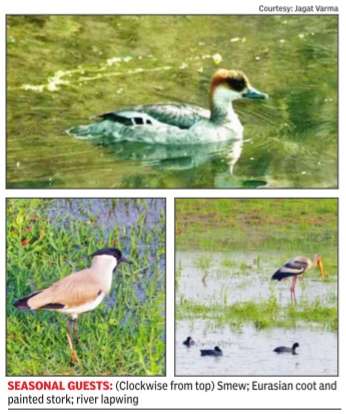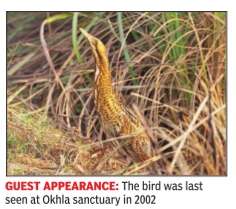Delhi: Birds
This is a collection of articles archived for the excellence of their content. |
Contents |
Okhla sanctuary
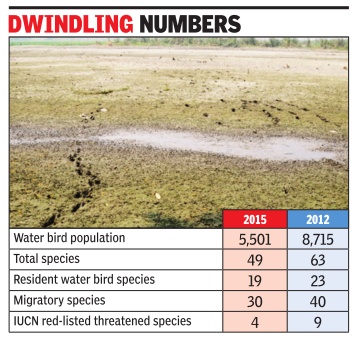
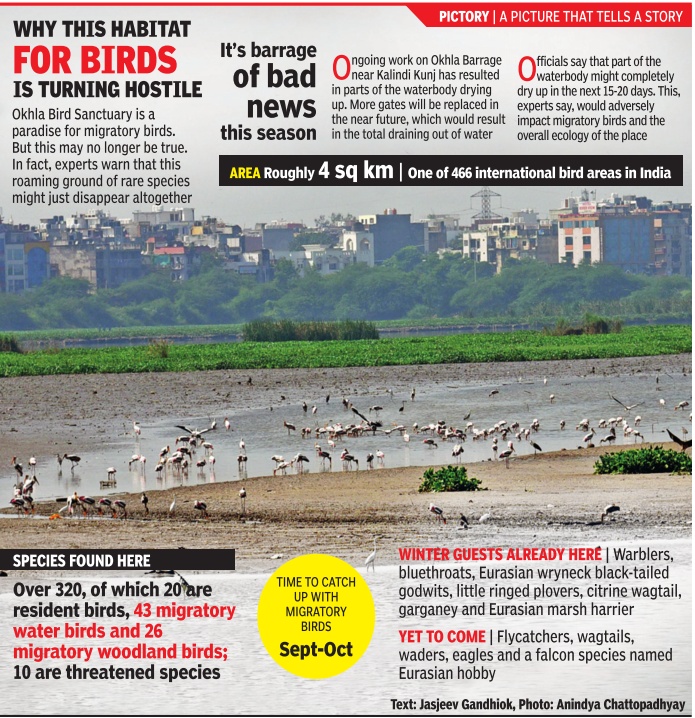
The Times of India, September 26, 2017
Barrage work leaves Okhla sanctuary dry
Okhla Bird Sanctuary is in a precarious state with vast stretches of its wetlands parched. Water has been diverted because the Uttar Pradesh irrigation department is changing three metal gates at the Okhla barrage. Officials said water would be released back into the wetlands only after April 24. Birders say the change in water levels may impact the habitat. The irrigation department, however, insists that the barrage gates have to be maintained every year. Officials claim that the gates have been corroded because of the poor water quality in Yamuna. “We have to do our annual maintenance work.But this time it will take us longer because three barrage gates have to be changed,“ said one of them.
But birders are worried that the seasonal guests will give Okhla a miss. “April onwards the breeding season starts for resident water birds like spot-billed duck, purple swamphen, little grebe, purple heron, common moorhen and others. Some migratory birds from within the country also come for breeding like the lesser whistling duck or streaked weaver. I think now they have to abandon the sanctuary , skipping their annual breeding,“ said T K Roy ,a birder and Asian Waterbird Census coordinator for NCR.
“I know for sure that the authorities managing the sanctuary don't want any birders to go there. This is mainly because of their nexus with the builders and possibly they want to kill the sanctuary as well. Once I was charged Rs 500 just to take a camera inside,“ said a birder on condition of anonymity . There are also complaints of too many vehicles being allowed to use the road inside the sanctuary and very little ecological buffer area that can preserve the habitat. Birders say about seven to eight years ago close to 50,000 ducks could be seen during the season.
The only saving grace this time is that the maintenance work by the irrigation department has been rescheduled to March and April instead of October. In 2013, it was carried out in October-November when migratory species start arriving from Central Asia and Europe. Birders stressed that if maintenance is absolutely unavoidable then it should be wrapped up within a few days and not stretch up to a month.
“We had requested them not to carry out the work in October-November that's why they are doing it now. All the migratory birds are gone except northern shoveler and Eurasian wigeon. We should understand that the wetland and the sanctuary were created because of this barrage and it has to be maintained,“ said a UP forest department official.
Sparrows
2018: dwindling numbers
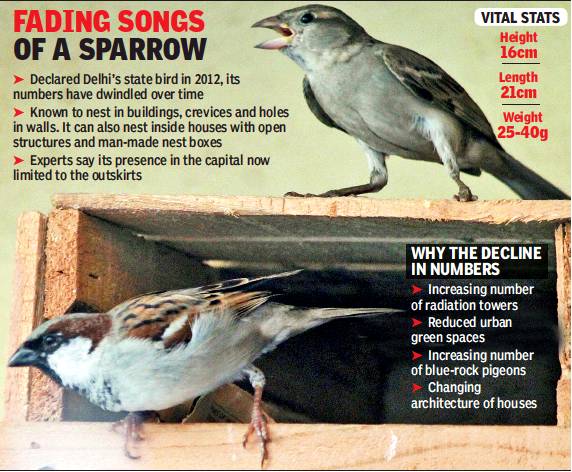
From: Jasjeev Gandhiok, Where have all the sparrows gone? Blame it on vanishing urban nesting spaces, March 20, 2018: The Times of India
AS DELHI MAKES RAPID STRIDES IN TERMS OF INFRASTRUCTURAL GROWTH, IT APPEARS TO BE COMING AT A HUGE COST
Once a bird that was synonymous with the chirping heard outside every home, the house sparrow is today a rare species in the capital — despite being Delhi’s state bird. And while the others celebrates World Sparrow Day on Tuesday, experts in the city ruing that the brown presence has disappeared due to reduction in urban nesting spaces and the presence of the blue rock pigeon which too is taking over the sparrows’ nesting areas.
Experts say it is hard to estimate the numbers left in the city, but most sparrows have shifted to the outskirts of Delhi. Said birder Nikhil Devasar: “The sparrow concentration has shifted to forests and urban villages outside Delhi. The fact is urban areas now have fewer trees and greenery where the sparrows can nest. Of course, the blue rock pigeons have also colonised places where sparrows can make nests.”
Since 2010, March 20 has been designated World Sparrow Day to highlight the decreasing presence of the once common bird. In 2012, the sparrow was adopted as the state bird of Delhi.
Experts say the birds act as an ecological indicator and the dwindling numbers signify urban lifestyle changes. “House sparrows have co-existed with humans, but in the last couple of decades they haven’t been able to keep up with architectural and lifestyle changes,” explained Sohail Madan, Asola centre manager, Bombay Natural History Society. “Houses used to be open and there were places for sparrow nests, but these have disappeared. Sparrows are moving to greener areas. We are seeing hundreds of them in Asola, for instance.”
Faiyaz Khudsar, scientist in charge at the Yamuna Biodiversity Park, was almost certain that non-availability of nesting space was one of the biggest reasons for the flight to the outskirts. “Today’s urban constructions are not sparrow-friendly — the bird cannot find resting space and finding food is also difficult because availability of insects and worms has reduced due to the use of insecticides and pesticides,” said Khudsar.
Experts confirmed that the species still lived in substantial numbers in green areas such as Lodhi Garden, Sanjay Van and the biodiversity parks around the capital. In fact, Dr Surya Prakash, zoologist at JNU, asserted the birds could be brought back to the city if feeders and nest-boxes were provided in large numbers. “We have worked in Shankar Vihar for a few years and seen sparrow population increasing. Delhi needs efforts of this sort,” Prakash said.
2013-18
Number of birds documented: Big Birds Day, 2013-18
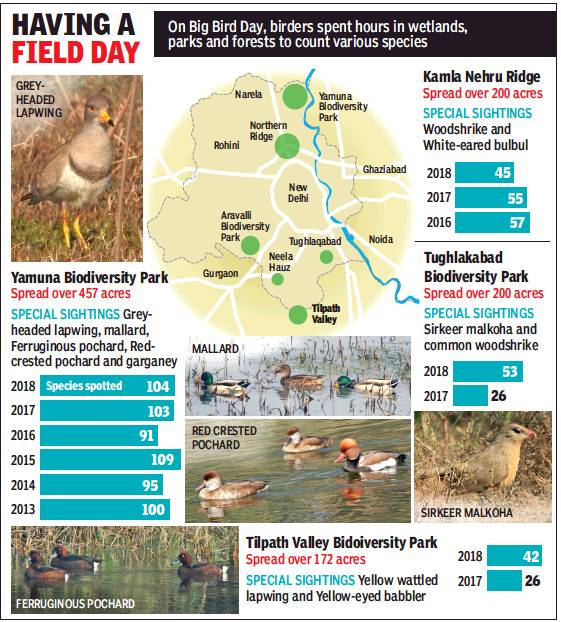
From: Birders flock together to get a count, February 19, 2018: The Times of India
See graphic:
‘Special sightings’ (of rare birds) on Big Bird Day in Delhi- NCR’s Bio-diversity Parks and the Ridge, 2013-18
2015
February 2015: Visiting birds
Feb 23 2015
Neha Lalchandani
Rare birds fly into city
Birdwatchers have reported a host of rare birds in the city this season. The sightings, they say, are a result of luck and the proliferation of birdwatchers with better equipment. With the environment of Delhi becoming worse with every passing season, birders say that rare birds have become even more difficult to spot which is why these sightings become extremely important. Kanwar B Singh, a Delhibased birder, says that usually during active western disturbances when it snows in the hills, birds from the Himalayas migrate to the adjoining plains, which is why maybe some of these rare sightings take place in winter.
“The state of the city's wetlands and water bodies has deteriorated over the past few years and has resulted in a fall in the number of species seen here.These sightings have more to do with the increase in number of birders, using more sophisticated equipment and better communication that help in correctly identifying birds,“ he said.
One such rare bird seen in Delhi recently is the Smew, a species of duck which was last reported from the Delhi region in 1922 by Basil-Edwardes. On November 16 last year, Jagat Prakash Verma saw the bird in the Jhajjar district. Birders say it is a significant record as the bird is an extremely rare visitor to India and is a vagrant.
However, according to records of AO Hume, the bird could be seen regularly at the Najafgarh drain till the late 19 th century. The Red-necked phala rope, another rare bird to be spotted in India, was recorded by Sanjay , the bird guide at the Sultanpur bird sanctuary in the beginning of February . This was the first recorded sighting of the bird in almost 35 years. The phalarope migrates from the north Arctic to the tropical seas. “It was sheer chance that it was seen here.
There are a few records of the bird in India in the past few years but in Delhi, it is an extremely lucky sighting,” said Singh.
The Slaty blue flycatcher from the Himalayan forests was seen by Singh on January 31. “It tends to venture into the forests of the Himalayan foothills during winter. However, there has never been any sighting from the Delhi region. I was pleasantly surprised to see one blue-coloured male feeding on the ground next to the jogging track at Nehru Park on January 31,” he said.
Ultramarine flycatcher, another Himalayan species, spends the winter in the forests of Western Ghats. Its recent sightings in the Delhi region were in October 2013 at Sultanpur by Savithri Singh and then in January by at Sundar Nursery by Ratish Nanda.
The Oriental scops owl, a very small bird, was last seen in 1925 by Basil-Edwards till it was spotted once in Palam Vihar in 2013 and then at the Najafgarh drain in January 2015.
The Smoky warbler, which is fairly common in east India, was also never conclusively seen around Delhi till this winter. Several birdwatchers saw it at the Basai wetlands this season.
The Lemon-rumped warbler, a Himalayan bird that barely ever descends into the plains, was seen sitting on a tree by Udiyaman Shukla from his balcony near All India Institute of Medical Sciences (AIIMS).
Birds spotted in March 2015
It was birders' day out with rare finds
TIMES NEWS NETWORK The Times of India Mar 09 2015
Sea Duck Spotted In NCR After A Century
It started out as a gloomy morning because of rain and low visibility in some parts of the city but the day turned out to be an ecstatic one for birders. Teams who participated in the Big Bird Day 2015 on Sunday not only spotted a great variety of species but also some extremely rare ones. A team that was birding in Jhajjar's Bhindawas spotted Smew, a European sea duck that was last seen in NCR between 1920 and 1925.
After close to a century, the birders were thrilled that the small duck species that breeds in northern Taiga of Europe and Asia continues to be seen around Delhi.
Another team that went to the Sultanpur bird sanctuary spotted a White-bellied drongo which is also an important sighting as its population is declining. However, Smew was the highlight of the day . “It was spotted in 1881 by AO Hume, who was a great birder and the founder member of Indian National Congress. In 1922, it was seen near the capital by Basil-Edwardes. Recently, there were also reports of it being spotted in West Bengal's Gajoldoba,“ said Bikram Grewal, one of the organizers of Big Bird Day .
Suresh Sharma, who was part of the team that spotted the Smew, said they also saw a Peregrine falcon and an Indian spotted eagle, thanks to their powerful binoculars. “We spotted 178 species on Sunday . Officials are apathetic towards Bhindawas Bird Sanctuary,“ said Sharma.
About 300 people, divided in to 12-14 teams, participated in this year's Big Bird Day . It is one of the largest birding events in the country where people spend a day birding and then upload a list of their sightings on an online portal called eBird. It was started by the Delhibird group--created by Nikhil Devasar and Bikram Grewal--as an informal event held in February or March every year. The first Big Bird Day was held on February 22, 2004, when 236 species of birds were recorded in NCR. The results for this year will be collated in a week.
At Yamuna Biodiversity Park, a team of 20 participated and spotted 109 species between 8am and 10am. A flock of small Pratincole was also seen in the flood zone of Yamuna. At Aravalli Biodiversity Park, counting started early in the morning. A team of six birders participated and listed 69 bird species.
2015: Sunder nursery
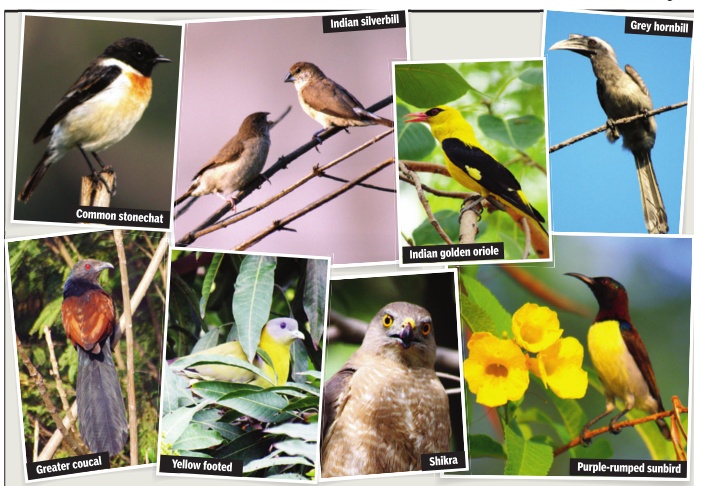
Apr 07 2015
Rare birds return to Sundar Nursery
Neha Lalchandani
A little off the beaten track, adjacent to Humayun's Tomb and next to a busy railway station is Sundar Nursery . Typically, one would expect to go there to buy plants but the 70-acre urban oasis is nowhere close to an ordinary nursery . This garden complex is replete with old trees and dotted with monuments dating back to the Mughal era. And it's after years of conservation work, the nursery , originally known as Azim Bagh, is back to its magnificent self. The revival of Sundar Nursery was taken up in 2007.Most of the land was hidden beneath tonnes of debris. The work of landscaping the nursery, along with restoration of 13 monuments, was taken up in 2009 by the Aga Khan Trust for Culture (AKTC) in partnership with CPWD.
The nursery was established by the British in 1913 to grow and develop plants for the new city of Delhi. It was taken over by the CPWD in 1945. At present, it houses the largest collection of tree species found in capital, including some rare ones.
The focus is also on developing a wide range of habitats within the nursery . It is fast becoming a fascinating site for birdwatching. Officials said the project aims at ecological restoration too.
“The landscape master plan was developed by architect M Shaheer and includes zones for a variety of functions. It has an exclusive zone for ground nesting birds such as peafowl. The complex used to be a key bird habitat till 1970s, but large-scale dumping of construction waste ruined the area. Our aim was to redevelop it with native flora and fauna. At present, the nursery has 1,800 large trees now mapped on a GIS system.Additionally , 5,000 tree saplings of over 200 native species have been planted. These species are mostly fruit-bearing and have been planted to attract more birds,“ said an official.
To develop it as a microcosm of Delhi, efforts are on to replicate the ridge biodiversity, along with khadar (riverine), bangar (alluvial) and dabar (marshy) zones.And since birds have started returning to the nursery , one can spot the black kite, grey hornbills, woodpeckers, yellow-footed green pigeons, spotted owlet, Indian roller, white-throated kingfisher, Eurasian hoopoe, Indian grey hornbill, brown-headed barbet, coppersmith barbet, Hume's leaf warbler, common tailorbird, oriental white eye and green bee eater.
Cormorants and painted storks--with their habitat at nearby Delhi zoo--too frequent the nursery even though many major water bodies are yet to be developed.“Water bodies are being developed to attract more birds.The earth embankments along the water bodies are already seeing kingfishers. In addition to that, denselyplanted zones have been established for ground nesting birds such as peafowl and francolin. These will provide a habitat secure from stray dogs,“ the official said.
Currently , AKTC has 77 species of birds, including ultramarine flycatcher and Eurasian golden oriole, on record in the Sundar Nursery area.
2015: Common pochard, steppe eagle and other dwindling birds
The Times of India, Nov 03 2015
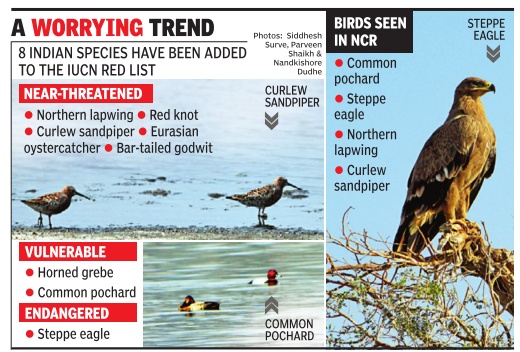
Jayashree Nandi
Common pochard now rare in NCR
Conservationists were alarmed in Nov 2015 to find one of NCR's once most-commonly sighted wetland bird, common pochard, to have been labelled `near-threatened' in the latest red list of birds released by International Union for Conservation of Nature (IUCN) for 2015 because of its depleting number. The duck was in the `least concerned' category till last year. But IUCN's latest report is proof of how wetlands here are either disappearing or are not able to support aquatic and bird life any more. The IUCN red list now has a total of 180 bird species in India in the threatened category as against 173 last year. This year, it has eight new species from India--northern lapwing, a grassland bird; water birds like red knot, curlew sandpiper, Eurasian oystercatcher, bar-tailed godwit, horned grebe, common pochard and a raptor--steppe eagle, which have been added to the list. The inclusion of common pochard and steppe eagle, a regular winter migrant bird, has shocked a lot of birders in NCR. “It is quite alarming. Their number is fast depleting. I think many factors like habitat loss and changing weather pattern are at play . I was in Maguri Beel in Assam yesterday and didn't spot a single duck. So it's not like only NCR birds are depleting. It's across the country ,“ said Bikram Grewal, author and birder. Even steppe eagle was earlier spotted a number of times at places like Aravalli Biodiversity Park and Asola Bhatti Sanctuary . It's a raptor that comes down to various grassland and ridge areas of NCR in the colder climes. Experts said grassland and waterbirds are the worst affected because there is little appreciation or understanding of these habitats. “They are in danger because here are not effective laws to protect these habitats.Grasslands and wetlands are still considered as `was eland' in many government records, so even a local revenue officer can give these habitats for other uses, while he or she cannot do this to fo rested areas as forest is pro tected under many laws. As long as we have this attitude both these habitats will keep on disappearing,“ said Asad R Rahmani, senior scientific adviser, Bombay Natura History Society (BNHS). The most pertinent ex ample is that of 3,000 hecta res of grassland in Karnata ka, a habitat for the critical ly-endangered great Indian bustard, which has been al legedly handed over to DRDO and other organisa tions. Conservationists are vehemently opposing this. Another wetland bird curlew sandpiper, is under threat due to marshland alteration by commercial salt works, and habitat degradation because of diminishing rainfall and hunting. In NCR, several waterbodies are too polluted to support plant life. In parts of the Yamuna, there is no hydrilla or vallisneria and other aquatic plants which many waterbirds feed on. “This is a very worrying report. Northern lapwing, a beautiful green bird, prefers marshlands. If you notice, marshlands are being encroached rapidly by infrastructure projects. The steppe eagle likes feeding on reptiles and insects but its food is depleting. Diclofenac use is severely impacting the raptors,“ said Faiyaz A Khudsar, scientist in charge, Yamuna Biodiversity Park. BNHS in its statement said, “Older BNHS studies had revealed that just like steppe eagle three vulture species--white-backed, slenderbilled and long-billed--have been severely affected by veterinary diclofenac. Subsequent research had also highlighted the diclofenac threat to red-headed and Egyptian vulture.“ IUCN red list is an information source on the conservation status of animals, birds and plant species. The list provides information on population size, geographic range and habitat needs.
October 2015: Winter visitors
The Times of India, Nov 01 2015
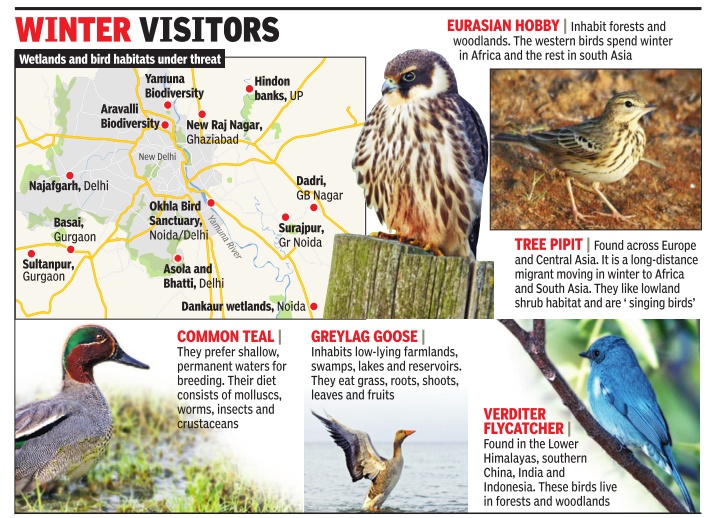
Foreigners are chirping around city
Proof that winter has arrived lies not just in the nippy mornings but in the sights and sounds of a variety of migratory birds that flock to the NCR every year. If you visit the capital's wooded areas, chances are you will be treated to the lark's or tree pipit's sweet song or may even manage to catch a glimpse of the magnificent Verditer flycatcher. Over the past week, a variety of migratory species riety of migratory species have arrived in the city, however, their numbers are not very big. “The reason for this is the warm climate. The common arrivals include the Black-tailed godwit, sandpipers, wagtails and warblers.I also spotted a Steppe eagle recently. Basai wetland in Gurgaon already has a lot of variety,“ said birder Nikhil Devasar.
At Aravalli Biodiversity Park, colourful terrestrial migratory species have become photographers' delight.“We have seen fewer whitethroats, Eurasian hobby , Black redstarts, blue-tailed bee eaters, Verditer flycatchers, shrikes and Singing tree pipits. We are still waiting for the thrushes. They are largebodied birds that like a lot of litter of dry leaves, sticks, grasses and shrubs on the ground. Thrushes are very important because they signify that the forest cover is good and intact,“ said Aisha Sultana, a field biologist at the park.
Birders said Mangar area along the Gurgaon-Faridabad highway and Asola Bhat ti sanctuary are also teeming with birds.
Suresh C Sharma and his friends spotted more than a hundred Graylag geese at the Bhindawas bird sanctuary in Haryana on Wednesday .“It's a very large number so I am optimistic about this year. I also saw more than eleven species of raptors like the Short-toed eagle, Crested serpent eagle, Common buzzard, etc,“ said Sharma, who also spotted water birds like pintails, shovelers and common teals.
Yamuna Biodiversity Park shows you how birds would have flocked to the river in its glory days. Scientists here have already spotted more than 200 Great cormorants and coots, about 20 to 30 Tufted ducks and four Common pochards.
“The river doesn't see these kind of biodiveristy anymore. I have seen some Ruddy Shelducks but that too only in the upper stretches the river. Ducks like phyto and zoo plankton are plantivorous so it's important that our water bodies have that vegetation,“ said Faiyaz A Khudsar, scientist in charge at the park.
A guide at Sultanpur bird sanctuary, Sanjay Sharma, said they are already flooded with visitors. “I think we have the highest numbers. About 15 species of water fowls and 15-20 species of woodland birds have arrived.“
2016
2016, summer: 188 species in Delhi, NCR
The Times of India, May 17 2016
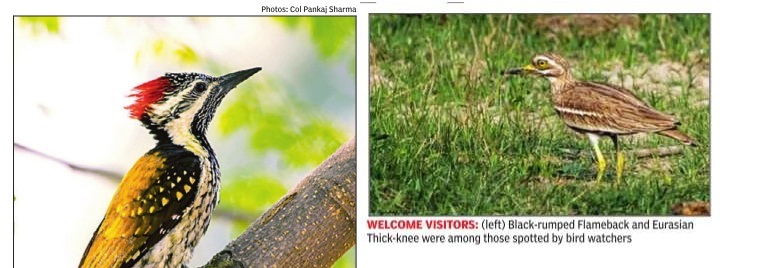
Summer bird count throws up a pleasant surprise
Neha Lalchandani
The first ever summer bird count in Delhi threw up some welcome results. Those who stepped out for birding on Saturday reported 188 species from across Delhi and NCR, “an encouraging sign“ since the winter count, when migratory bird numbers are substantially more, is between 240 to 250 species.
K B Singh, a birder who led one of the 15 teams, said that the data collected on Saturday provided important information on sites of breeding birds in Delhi and NCR. “Delhi summer bird count was an entirely voluntary initiative by the birdwatchers of the capital.The region has a very rich birdlife, including resident birds that breed here, local migrants, summer breeding visitors and winter migrants that arrive with the onset of colder season. All observers contributed their sightings and records to eBird, an online database of bird observations. Despite the torrid summer heat, the team led by veteran birder Suresh Sharma recorded over 110 species from near Sonipat. Importantly , there were five teams with a tally of over 100 species recorded during the course of the morning birding,“ he said.
The summer count shows that despite massive pressure on habitats, Delhi remains rich in resident birdlife. Birders report that 95 resident species were seen fairly commonly across the city . In addition, over 40 species of birds were easily sighted in the appropriate habitats. Another 15 resident species, considered uncommon or rare for the region, were also reported, including White-bellied drongo, Crested bunting, Black-headed cuckoo-shrike, Indian pitta, Red-headed vulture, Painted sandgrouse, Oriental pratincole, Dusky eagle owl, Indian courser, Black-necked stork and various crakes.
“Most of these species occur in the ridge or on Yamuna flood plains, highlighting their role as important bird habitats,“ said Singh.
Of the 152 resident species, there were 32 endemic species -birds seen only in India. Interestingly , 36 species of win ter migrants were also found lingering in the region despite the high temperatures.
Singh said suitable habitats were largely responsible for the good number of species observed. For instance, he said, Yamuna and its flood plains are the richest in terms of avian biodiversity. A team led by Sunil Kumar, which covered the area, reported over 110 species from this riverine belt.The reed beds of the flood plains and the sand dunes are important for Black-bellied terns, Indian skimmer, Great thick-knee, White-tailed stonechat etc.
The Najafgarh drain and adjoining low lying areas, including the nearby wetlands of Basai and Sultanpur, are also important birding habitats.“Dry stony habitats of the ridge like Asola, Sanjay Van, Delhi Cantt, Rajokri, Mangar, Damdama, Faridabad, etc look deceptively barren but are important habitats for many of endemic and endangered birds like Painted sandgrouse, Rufous-fronted prinia, Indian pitta, Jungle prinia etc. Important wetlands in the adjoining districts of UP and Haryana like Dhanauri, Dadri, Surajpur, Bhindawas, Dighal and Sonipat are under tremendous pressure from urbanisation but continue to be important birding habitats,“ said Singh.
2016, Winter
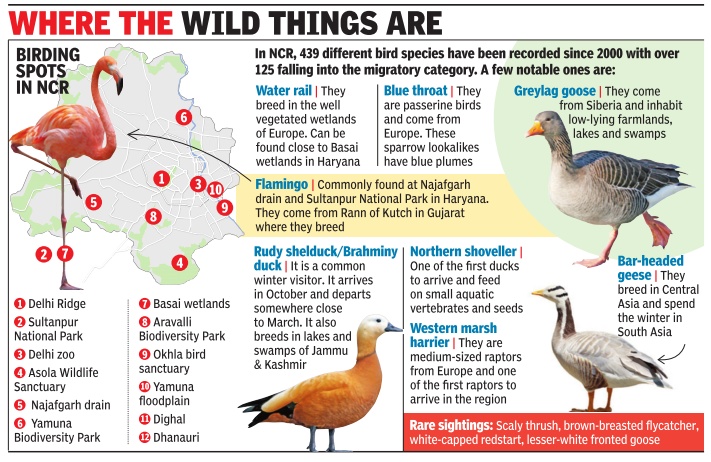
The Times of India, December 19, 2016
A sight to behold: Winged visitors arrive in droves
Jasjeev Gandhiok With winter having set in and temperatures dropping, flocks of migratory birds, some from as far away as Africa and Europe started arriving in the capital.
Birders across NCR have already made a number of rare sightings, including a scaly thrush and a brownbreasted flycatcher spotted near Mangar Bani, a lesser white-fronted goose at Dighal, and a white-capped redstart near Sonipat.
Birder Anand Arya who had spotted the lesser whitefronted goose last year said it was again sighted at Dighal, Haryana, in November.“Even though the bird has been spotted twice now, it is still a rare sighting,“ he said.
There are no records of a scaly thrush ever being sigh scaly thrush ever being sighted in NCR. Experts feel it may have strayed from its path. “The bird is usually fo und in the foothills of the Himalayas or near Odisha. We are still trying to figure out how it may have ended up here. It will be interesting to see if it is taking a break or will be spending the winter here,“ said birder Pankaj Gupta, who spotted the bird near Mangar Bani.
Birder and zoologist Surya Prakash said spotting the lesser white-fronted goose at Dighal and a scaly thrush near Mangar Bani are good signs for the aquatic ecosystem.
“It is likely that these birds were spotted as village ponds and other waterbodies were full this year due to a better monsoon,“ explained ornithologist Bikram Grewal.
More birds are visiting NCR this winter as compared to last year. “It has been a good winter so far in terms of migratory birds sighting,“ said Prakash.
Other rare sighting include the common buzzard and the oriental pratincole near the Yamuna, a brown shrike in Najafgarh and the largetailed nightjar near Mangar village. Among common migratory birds that have arrived in large numbers are northern pintails, common teals, northern shovellers, gadwalls, Eurasian coots, red-crested pochards and bar-headed geese.
Grewal and other birders spotted a pair of Eurasian bittern last week, a European bird seen in the region every few years. The ornithologist feels few species have been spotted in Okhla Bird Sanctuary this year as most birds seem to prefer other areas such as the Najafgarh drain and Dighal.
Another popular area for birders this year has been Dhanauri in Greater Noida.Around 25,000 birds have arrived at the wetlands there. It is also a good place to spot sarus cranes. Even Surajpur has attracted a lot of birds in 2016.
Racket-tailed drongo
2016: Sighted after 41years
The Times of India, Jul 03 2016
Jasjeev Gandhiok Bird lovers and wildlife enthusiasts in the city are thrilled at the discovery of a Racket-tailed drongo which has been sighted after 41years.The bird was seen at Sunder Nursery , a heritage garden which is known to attract a number of migratory birds. “I have been coming to the Sunder Nursery for years, but I have never seen a racket-tailed drongo here before. I was extremely surprised as they are usually found in thick forests and hilly areas,“ said wildlife photographer Vinod Goel. This bird has a unique characteristic of mimicking the sound of other birds in the wild, which helps it catch its prey . The bird was last sighted in the city in 1975, with unconfirmed sightings reported in 1991. “While the black drongo is common in Delhi, the racket tailed-drongo is much rarer.This particular bird mimics other birds in the area, particularly raptors. It deters them by mimicking their call and then swoops in on its prey ,“ said Faiyaz A Khudsar, scientistincharge at the Yamuna Biodiversity Park.
According to Bikram Grewal, author of several bird books, it is a significant sighting.“It's a good sign for Delhi, especially bird lovers who should keep a lookout in the area. The sighting is unusual, as the species hasn't been spotted in decades. The breeding season is also going on,“ Grewal said.
Eurasian bittern
Sighted in 2016 after 2002
Sharmila Bhowmick, Eurasian bittern spotted in 2016 after 2002, Dec 27, 2016: The Times of India
It was last seen in the marshes of Okhla Bird Sanctuary in 2002, as per written records of the birding community . The Eurasian bittern has been sighted again in the NCR this year, during the Christmas weekend. Birders are now pleasantly surprised as the rare heron has visited these parts after 14 years.
The Eurasian bittern or great bittern (Botaurus stellaris) is a wading bird in the bittern sub-family of herons. It is considered as an endangered bird species.
“This is most unusual. We went to Dhanauri wetlands during the weekend, and suddenly this bird appeared from behind bushes. We made photographic records and informed all birder groups. It is indeed important news for the birding community,“ Mudit Bhatnagar, a senior member of the Delhi Bird Photographers group, said.The group is a community of birders who regularly spot, photograph and document birds in their habitats in the wetlands of Delhi, Noida, Greater Noida and Gurgaon.They maintain a year-long calendar of birding events. In NCR, over 100 birders regularly go on photo-walks in small groups to explore and spot birds.
“Bird watching is gaining popularity as a hobby and passion. Spotting birds is closely related to photography as well, and we find a lot of enthusiasm in the participants of our community every weekend,“ Mathew Joseph, founder, Delhi Bird Photographers group, said. The group, founded by Joseph two years ago, has so far done 150 photo walks in Noida and Greater Noida's wetlands, Okhla Bird Sanctuary and in Gurgaon. “Apart from the bittern, birders also spotted Bonelli's Eagle, Greater Spotted Eagle, Marsh Harrier, Black Shouldered Kite, Sarus Crane, Painted Stork, Spoonbill and Common Greenshank, during the weekend at Dhanauri,“ said Maneet Pal Singh, who also spotted the bittern along with other birders during the weekend. Dhanauri wetland, popular for huge numbers of Sarus, is increasingly becoming an important birding destination.Migratory as well as domestic birds are shifting to the greener, less congested interiors and rural ends, as habitats for nesting and roosting.
Song Thrush and Brown Hawk Owl
Jasjeev Gandhiok, Rare winged visitors thrilled birders in 2016, Jan 1, 2017: The Times of India
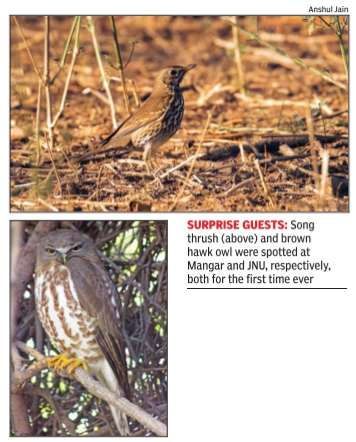
It was a successful year for ornithologists and birders in the National Capital Region after a number of rare species were sighted in the region. In Delhi particularly, species like the song thrush and the brown hawk owl were spotted at Mangar and Jawaharlal Nehru University, respectively, both for the first time ever.
In addition, sightings of ra re and vagrant species like scaly dark throated thrush, orange headed thrush, white capped water redstart and Marshall's Iora were reported in NCR through the year. For bird enthusiasts, the Dhanauri wetlands and Mangar remained the most favourable birding hot spots with most sightings of new and rare bird, including the great bittern, taking place there.
“A song thrush is a rare bird for India, let alone Delhi, and this year was the first time it was sighted in the capital,“ said birder Kanwar B Singh.“Also recorded for the first time within Delhi was the brown hark owl, usually only seen on the periphery of NCR.“ Experts, however, said that the reason for such sightings was not because Delhi's habitat was improving, but because more people were now getting involved in the hobby of bird watching.
As Dr Surya Prakash, zoologist and ardent bird watcher, pointed out, “More people are now focusing on birds and are fully loaded with the technology and equipment required for bird watching. Also, a number of small groups have been monitoring specific areas on a regular basis and reporting sightings to others through e-groups. That has helped us find and spot more birds.“
Sultanpur National Park and Okhla Bird Sanctuary were other hot spots for ornithologists, with species like Whistler's warbler, blue capped rock thrush, brown breas ted flycatcher and orange breasted pigeon being spotted there. Other rare species like the forest wagtail, pallid scops owl, griffon vulture and oriental pied hornbill were also observed there.
The Asola Bhatti area proved beneficial with a grey winged black bird and a large cuckoo shrike seen there, while the Yamuna Biodiversity Park's Phase II reported the sightings of Stoliczka's bushchat and grey headed lapwing.There was photo documentation of two new woodpeckers from Aravalli this year: the streaked woodpecker from Asola and the brown capped pigmy woodpecker from Mangar. In addition, reportings were also made within Delhi of a greater racket tailed drongo at Sunder Nursery and a great pied hornbill at Greater Kailash.
2017
2017, Big Bird Day: 268 Species Spotted
Jasjeev Gandhiok, Birders thrilled with more sightings this yr, Feb 10, 2017: The Times of India
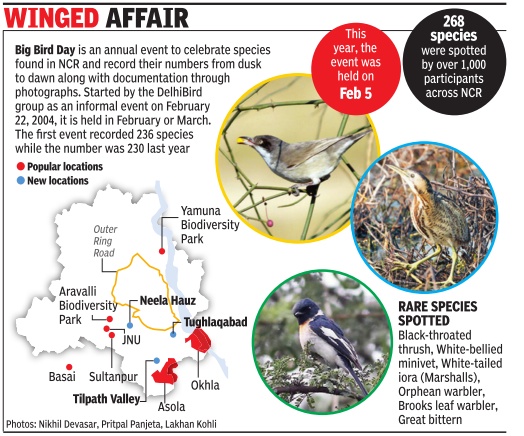
268 Species Spotted On Big Bird Day In 2017
Good monsoon and an abundance of food across wetlands in Delhi and its neighbouring areas made it a fruitful year for birders, with more species being spotted than last year. The results of the Big Bird Day , an annual event aimed to record bird species found across the country , were released on Thursday . According to them, 268 species were recorded this year, up from 228 in 2016.
The event was conducted on Feburary 5 by the DelhiBird group and over 40 groups participated, each comprising close to 25 birders.Schoolchildren also took part in this year's count.“The response this year has been very good. Over 1,000 birders participated and we chose some new locations like Neela Hauz, Tughlakabad and Tilpath Valley for bird counting. More diversity was seen this year, along with many rare sightings, as the wetlands across the NCR are still full of water. A good monsoon has certainly helped and there is a lot of food for these birds,“ said Nikhil Devasar, organiser of the Big Bird Day . According to Devasar, a number of rare sightings were also made this year, which included birds like the Great bittern and Water rail in Dhanauri; a White-bellied minivet and White-tailed iora near Sohna; and a Blackthroated thrush in Dighal.An Orphean warbler and a Brooks leaf warbler were also spotted this year. “More birders are coming out, which means more eyes are there to spot these birds. We also participate in birding activities every Sunday and encourage people to join in and learn,“ Devasar added.
A total of 103 species were seen at Yamuna Biodiversity Park this year as compared to 91 last year. The rare sightings included orange headed thrush and a white-tailed lapwing. Kamla Nehru Ridge recorded 55 species this year, including a red-throated flycatcher. Tughlakabad Biodiversity Park, where this event took place recorded 26 species, including a steppe eagle sighting.
“A Marshall's Iora and a brooks leaf warbler were spotted by our group at Mangar forest, where we spent a lot of time before heading to Aravalli Biodiversity Park. The findings have been particularly fruitful this year,“ said birder Pankaj Gupta.
Bird census/ February 2017
Jasjeev Gandhiok, 39 new bird species flock to census list , March 12, 2017: The Times of India
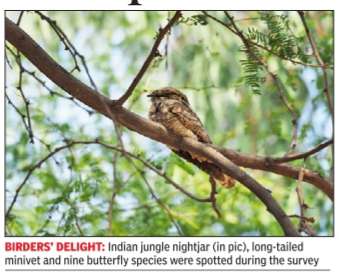
Ahead of plans to open seven city forests for the public, department of forest and wildlife conducted a bird and butterfly census last month at the Mitraon city forest.
The census revealed 39 different species, including rare sightings like the Indian jungle nightjar, long-tailed minivet and nine butterfly species.
The department has now plans to conduct several surveys at city forests like Garhi mandu, Issapur, Bela farm, Shastri Park and Alipur to determine the kind of habitat it has to attract birds. “We had a successful census at Mitraon where 10 acres has already been opened for the public. Now we will conduct a census next at Isapur. These will give us an indication of the habitat there so that we can prepare accordingly ,“ said a senior forest officer.
Sohail Madan, centre manager, BNHS (Asola) said that the preliminary survey reports were very promising. “This urban forest holds a great diversity of birds and butterflies, which is a boon for the residents.The highlight of the survey was an Indian jungle nigh tjar, which is a nocturnal bird and is extremely elusive for Delhi. Apart from that, we have spotted small minivets and long-tailed minivets, which are endemic to this part of the city ,“ he added.
The census also recorded a red-breasted flycatcher, a golden flameback woodpecker, two types of raptors, including a shikra and eight spotted owlets among others. The butterflies found included the cabbage butterfly and the common emigrant.
Forest officials said that the next census might begin by the end of this month, with modifications made to the city forests based on the findings.
Egyptian vulture (Neophron percnopterus)/ 2017
Endangered Egyptian vulture rescued from E Delhi temple, November 30, 2017: The Times of India
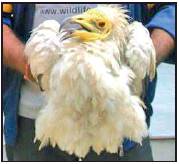
From: Endangered Egyptian vulture rescued from E Delhi temple, November 30, 2017: The Times of India
An endangered Egyptian vulture found injured in a temple complex in Patparganj, east Delhi, was rescued.
The bird was discovered by a priest who informed NGO Wildlife SOS, which sent a team of handlers to the temple. Egyptian vulture (Neophron percnopterus) also called the white scavenger vulture or pharaoh’s chicken is the smallest among all vultures. It is identified as globally endangered on the International Union for Conservation of Nature (IUCN) red list. The NGO said this is the second time an Egyptian vulture has been rescued this year.
“It is rarely spotted in Delhi but in recent years, there have been sightings near Yamuna Biodiversity Park and Okhla Bird Sanctuary. Their population is decreasing because of factors like loss of prey base and habitat, poisoning from veterinary drugs and even electrocution,” said Kartick Satyanarayan, co-founder, Wildlife SOS.
The bird will be kept under observation for the next few days and will only be released in the wild when it has completely recovered, officials said.
2017, Dec.: winter sightings
See graphic:
Birds sighted in Delhi in December 2017, region-wise
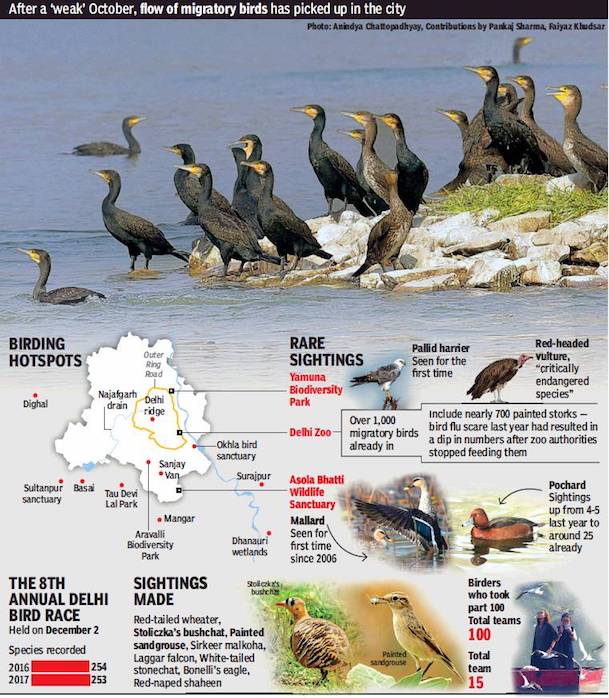
From December 11, 2017: The Times of India
2018
2017>2018: drop in number of bird species (268 to 238)
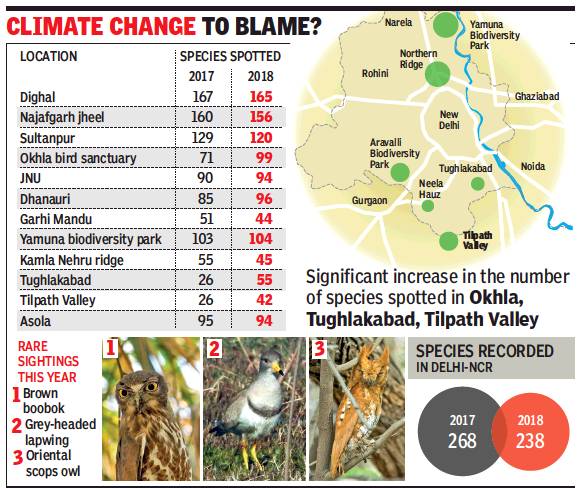
From: Jasjeev Gandhiok, Big Bird Day records number of bird species down to 238 from 268, March 5, 2018: The Times of India
NCR has recorded a drop in overall bird species on the Big Bird Day — an annual birding event across the region where birders set out to record different species with 238 species counted this year as compared to 268 in 2017. Bird species across different locations in the capital also recorded a slight drop compared to last year, however there has been significant increases in locations like Tughlakabad, Tilpath Valley and Okhla bird sanctuary when compared to data from last year.
The important sightings recorded this year included the oriental scops owl — last seen in 2011on the outskirts of NCR and extremely rare for the region; a brown-hawk owl which was sighted at Asola and a pair of grey-headed lapwing at the Yamuna Biodiversity Park. “We are studying if the migratory owl species have become residents in the capital or not,” said Dr Surya Prakash, zoologist, JNU.
Birders across the region feel the overall drop in numbers could be due local climate change which may be affecting the migratory pattern of certain species, forcing them to leave early. “By this time last year, a lot of the species hadn’t left but this time temperatures have been very high and a few species have left. There has been little rainfall this winter and the temperature has been warmer than normal which could have resulted in this drop,” said Nikhil Devasar, organiser of the event.
According to the results, bird species almost doubled at Tughlakabad this year, increasing from 26 last year to 55 this time around while Tilpath Valley recorded 42 species this year as compared to 26 last year.
Faiyaz Khudsar, scientist in-charge at the Yamuna Biodiversity Park, said the increase at these locations could be due to better protection. “Grazing at Tilpath and Tughlakabad was reduced this year which has protected the scrublands and resulted in an increase in insect and invertebrate diversity. This in turn attracts more bird species to the area,” he said.
Okhla also recorded a significant improvement with 99 species recorded this time around as compared to 71 last year. Team captain Jaswinder Waraich said the increase could be attributed to careful scanning of the area and increased available of food this year. “The important sightings at Okhla this year included booted eagle, mallards, grey bushchat and greater spotted eagle,” said Waraich.
Water birds double from 2017
Jasjeev Gandhiok, Waterbird census on, numbers double in 2018, January 14, 2018: The Times of India
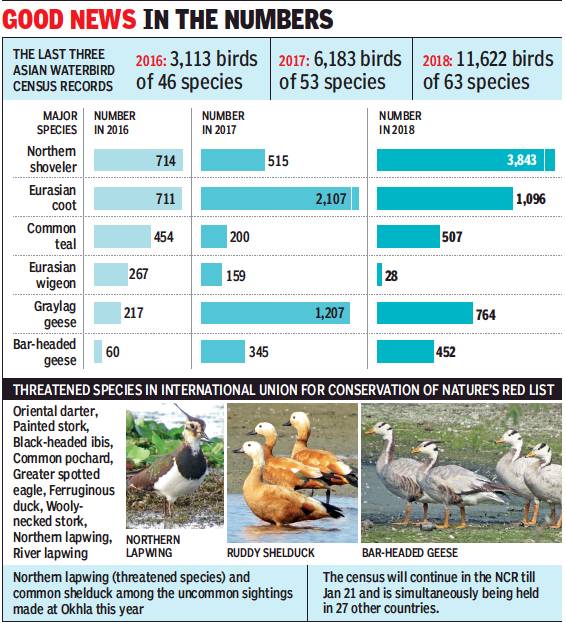
Threatened species
From: Jasjeev Gandhiok, Waterbird census on, numbers double in 2018, January 14, 2018: The Times of India
See graphic:
Water birds in Delhi, 2016-18;
Threatened species
With the Asian Waterbird Census (AWC) 2018 currently underway in Delhi-NCR, the findings of the first few days at Okhla Bird Sanctuary have revealed that the bird count has almost doubled since 2017. There has also been an increase in the number of species at the sanctuary.
This year’s count at Okhla Bird Sanctuary revealed 11,622 water birds as compared to 6,183 birds, which were recorded last year. In addition, the number of different species has also risen to 63 as compared to 53 in 2017. These include nine species that fall under the IUCN red-list of threatened species.
The Okhla Bird Sanctuary is one of the 466 Important Bird Area sites located in India. The census was carried out by Wetlands International South Asia, in collaboration with Gautam Buddh Nagar Forest Division, and a team of 30 members from different universities and Bombay Natural History Society.
AWC Delhi state-coordinator and ecologist TK Roy said that the census has also revealed sighting of two uncommon species at the sanctuary this year — the northern lapwing and the common shelduck.
“This a good sign for the ecology of the area. Both birds are not very common to the area. In fact, the northern lapwing has been sighted in India after several years. The count of species has also risen this year and there has been a steady growth in the numbers over the past two years. This shows that there has been a revival at Okhla,” Roy told TOI.
In 2016, 3,113 birds were recorded at Okhla, which consisted of 46 different species. The same number has increased to 11,622 this year, consisting of 63 different species. The oriental darter, painted stork, black-headed Ibis, common pochard, greater spotted eagle, ferruginous duck, wooly-necked stork, northern lapwing and the river lapwing are among the IUCN red-list threatened species sighted at Okhla this year.
Roy attributed the considerable increase in number of bird count to more northern shovellers arriving at Okhla in 2017, along with a mixed flock of black-headed and brown-headed gulls.
“These birds would earlier spend their day around Yamuna and come to Okhla at night. This year, however, they are staying at Okhla all day. This has resulted in an increase in the overall count of birds,” Roy added.
The numbers could have been even more, Roy said, but for the repair work at Okhla barrage in October, which saw a number of waders leave the sanctuary.
The census, which will continue till January 21, will also cover other locations like the Yamuna floodplains, Delhi zoo, Sanjay Lake, Najafgarh drain and Surajpur wetlands.
Number of birds documented: Big Bird Day 2018
Birders flock together to get a count, February 19, 2018: The Times of India
Hundreds of birders gathered at wetlands, forests and biodiversity parks of the capital to spot and document as many bird species as possible. They were participating in Big Bird Day 2018, an annual national event started by a birding group, Delhibird.
About 38 teams from Delhi-NCR participated in the event, each having 10-40 birders. The results, which will take a couple of days to be compiled, play a crucial role in documenting the number of birds and diversity in the country.
In all, more than 10,000 birders from across the country participated. In Delhi-NCR, birding sites like Dighal, Sultanpur, Basai, Asola, Najafgarh, Yamuna Khadar, Mangar Bani, Dhanauri, Dadri, Okhla Bird Sanctuary, Aravalis, Yamuna Biodiversity Park etc were explored. “It’s very difficult to give the trends right away. We haven’t got any reports of exceptional sightings from Delhi-NCR yet,” said Nikhil Devasar, one of the organisers who spent a part of the day at Dighal.
Yamuna Biodiversity Park recorded 104 species this year as compared with 103 last year. Rare sightings included the Grey-headed lapwing, Ferruginous pochard, mallard, Red-crested pochard and garganey. “The Grey-headed lapwing is an important sighting and we have been seeing for two weeks now. It is a rare bird for Delhi...the count also helps us to know the right habitat and environment. A high count of birds means that the habitat is thriving,” said Faiyaz A Khudsar, scientist in charge, Yamuna Biodiversity Park.
At Kamla Nehru Ridge, the number of species spotted went down to 45 this year from 55 in 2017. Woodshrike and White-eared bulbul were the rare sightings in the area.
However, numbers at Tughlakabad Biodiversity Park and Tilpath Valley rose significantly this year to 52 and 43 species recorded respectively as compared with just 26 species at each of the locations last year.
The sightings at these locations included a Sirkeer malkoha, common woodshrike, Yellow wattled lapwing and Yellow-eyed babbler, among others.
M Shah Hussain, scientist in charge at Aravalli Biodiversity Park said, “A total of 900 birds of 79 species were spotted during the count period. Important bird species that were seen in Aravalli Biodiversity Park included Jungle bush quail, Eurasian eagle owl and Oriental skylark”.
He added, “Tufted duck was also sighted at Neela Hauz Biodiversity Park after its restoration. The highlights, Jungle bush quail and Eurasian eagle owl, are rare for south Delhi”.
Only 594 waterbirds seen
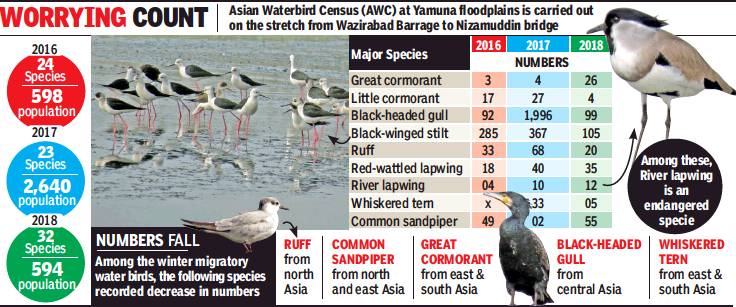
From: Jasjeev Gandhiok, Hope flies away as only 594 waterbirds seen in 2018, January 21, 2018: The Times of India
Sharp Fall In Numbers Over Last Year At Yamuna Floodplains
The population of waterbirds in the Yamuna floodplains has gone down considerably this year, though the number of species sighted rose from last year’s 23 to 32 this time around, the latest findings of the Asian Waterbird Census (AWC) 2018 have shown.
The number of water and water dependant birds were recorded at 594 this year – a sharp drop from the 2,640 birds last year, which experts attribute to human interference on the floodplains, climate change and pollution.
“Due to global climate change, shrinking wetland habitats and changing trends of long distant winter migratory birds, there has been a reduction in the numbers at Yamuna. Last year, the majority of these numbers consisted of black-headed gulls, which have now gone to Okhla this year,” AWC state coordinator TK Roy toldTOI.
The census, which is simultaneously being conducted across 27 countries, was conducted at Yamuna floodplains between Wazirabad barrage and the Nizamuddin bridge on January 13, by volunteers from several universities, Greenpeace, experienced birders from Delhi and the AWC Delhi state coordinator and ecologist, TK Roy.
Last year’s census recorded 1,996 black-headed gulls at the Yamuna floodplains, however these numbers fell to just 99 this year. Among the other birds which fell in numbers was the common sandpiper, great cormorant, whiskered tern and ruff.
Roy said that out of the 32 species, only the river lapwing is classified as threatened according to the IUCN red list, which rose from 10 last year to 12 this time. The count identified 13 species from the 32 as resident water birds, with the remaining 19 as winter migratory birds. The AWC in 2016 had recorded 24 species with 598 birds in total.
The AWC began on January 6 in Delhi and will continue till January 21. Among the areas covered include the Okhla Bird Sanctuary, Najafgarh drain, Yamuna floodplains, Delhi zoo, Sanjay Lake and Surajpur wetlands. Findings at Okhla last week had shown that the number of birds has almost doubled this year, increasing from 6,183 birds in 2017 to 11,622 birds this year. Roy said the final phase of the census is currently underway at Delhi zoo, with the results likely to be out in the next few days.
Summer 2018/ 174 species recorded
Jasjeev Gandhiok, Flying high: Birders record 174 species, May 31, 2018: The Times of India
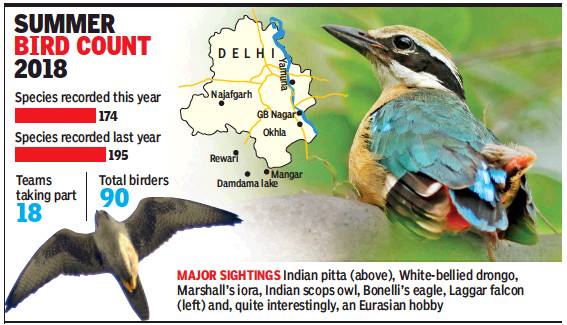
From: Jasjeev Gandhiok, Flying high: Birders record 174 species, May 31, 2018: The Times of India
It was a fruitful morning for birders as 18 different teams set out across different parts of Delhi NCR for the 3rd annual edition of the summer bird count, results of which came out. A total of 174 species were recorded in 2018– a sharp drop from the 195 species which were recorded in 2017. However birders attributed this to an early summer and the fact that the count was organised by the end of May instead of early May, so no “winter migrants” were recorded.
“In the previous years, the summer bird count was held in early May and we usually had 35-40 lingering winter migrants making it to our total species count. To avoid that, we have held the count much later this year and therefore we’ve seen a drop in the number. As a result only 10 lingering migrants were recorded,” said Kanwar B Singh, a birder and organiser of the event.
Singh said that 90 birders took part this time, including two teams consisting only of children. A team led by Brigadier Arvind Yadav covered the bird habitats along the Najafgarh drain, with a total of 108 different species recorded there, including the oriental pratincole that breed there during the summer months. The team also managed to sight a ruddy-breasted crake – an uncommon bird usually found in the reedbeds.
At the Yamuna floodplains, a total of 90 species were recorded which included summer breeding residents like little tern, cotton pygmygoose, white-tailed stonechat and river lapwing among others. For the first time in the count, the neighbouring district of Rewari was also covered with a team led by Dr Parikshit Yadav recording 103 species. A number of uncommon and important sightings were also made in Mangar and Damdama lake which included the sighting of the Indian pitta – a breeding visitor to forest patches in the area.

